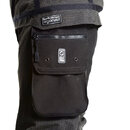I was wondering if anyone else has put 1lb weight in their drysuit pockets to help with trim.
I've been experimenting with a couple of other sets of doubles aside from my usual set and have been having a hard time trimming them out. My usual set is double HP 100's by faber. I've been playing around with an older set of double PST 100's which are the shorter in length, 3500 psi set. My usual set of doubles trims out perfectly with only 2lbs of tail weight. For the life of me I can't get this shorter in length set to trim out on my body (have moved wing/plate/bands/everything, have heavy jet fins) without an excessive amount of tail weight.
My drysuit pockets are similar to the picture I posted below, with both a velcro and a zipper compartment. I don't really use the zipper compartment in general. Was wondering if anyone ever put 1lb weights in their zippered drysuit pocket compartment to help with trim. I tried it in the pool the other day with these tanks that are difficult to trim out for my body and it made a giant difference since it moved weight way down my body's axis. It's invisible since it's in the zippered compartment unlike ankle weights. It's only 2 lbs total (1lb each side). Didn't cause leg fatigue since they are sitting on the thigh and am frog kicking. Seemed like a reasonable solution to keep the amount of tail weight needed to a minimum.
I've been experimenting with a couple of other sets of doubles aside from my usual set and have been having a hard time trimming them out. My usual set is double HP 100's by faber. I've been playing around with an older set of double PST 100's which are the shorter in length, 3500 psi set. My usual set of doubles trims out perfectly with only 2lbs of tail weight. For the life of me I can't get this shorter in length set to trim out on my body (have moved wing/plate/bands/everything, have heavy jet fins) without an excessive amount of tail weight.
My drysuit pockets are similar to the picture I posted below, with both a velcro and a zipper compartment. I don't really use the zipper compartment in general. Was wondering if anyone ever put 1lb weights in their zippered drysuit pocket compartment to help with trim. I tried it in the pool the other day with these tanks that are difficult to trim out for my body and it made a giant difference since it moved weight way down my body's axis. It's invisible since it's in the zippered compartment unlike ankle weights. It's only 2 lbs total (1lb each side). Didn't cause leg fatigue since they are sitting on the thigh and am frog kicking. Seemed like a reasonable solution to keep the amount of tail weight needed to a minimum.





